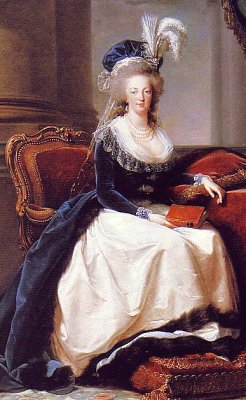 |
|
Marie Antoinette, Queen of France
Elizabeth Louise Vigee Le Brun, French 1755-1842
SN 383, Pastel 19th century
by Robert Anderson.
Artist:
Vigee Le Brun was a French painter who achieved an international reputation for her
stylish portrayals of royalty and aristocratic society in France and throughout Europe
during the period 1755-1825. Before the outbreak of the French Revolution she was closely
associated with Marie Antoinette of whom she painted over thirty (30) portraits.
She had an admiration for Rubens and experimented with a warm range of
colors and the use of multiple, thin layers of transparent or translucent paint. She
employed delicately animated poses, expressive faces and fashionable dress for her female
sitters. Faces were finely molded with vitality imparted to skin tones thru a delicate
layering of color.Vigee Le Brun was aware of her female subjects' affectations and had the
ability to flatter them as can be gauged from the contrasting directness and intensity of
her portraits of men.
After the Revolution she left France to travel to Italy, Russia and
England where she continued to be extremely successful with an ability to command
extraordinary fees which were much more than her contemporaries could obtain.She received
distinguished patronage wherever she went and was admitted to several academies including
the Royal Academy of France. |
Her memoirs give a lively picture of the Europe of her day as well as an
account of her own works and show what a redoubtable woman she was. These memoirs provide
an intimate account of the life of a woman artist working in the orbit of the French court
in the late 18th century.
Subject:
The portrait is that of Marie Antoinette, Queen of France. She was born in 1755, the
youngest child of Empress Maria Theresa of Austria. Marie was married to Louis - Auguste,
the Dauphin of France in1770 and became Queen upon the death of Louis XV in 1774.
Marie Antoinette was the most extravagant member of a most extravagant
court. She had been cheated of a normal sexual relationship with her husband due to his
impotency and while indulging in no liaisons, amused herself until 1778 with costly
dresses, gems, and palaces, with operas, plays and balls. She lost fortunes at gambling
and gave other fortunes to favorites in reckless generosity. Her husband Louis XVI gave
her sets of rubies, diamonds and bracelets. The thoughtless extravagance was the result of
boredom and frustration as well as the result of a childhood and youth accustomed to
riches and ignorant of poverty.
An operation finally cured the King's impotency and Marie had children
starting in 1778. From that time on the spoiled and reckless Queen became a tender and
conscientous mother. The people of France, however, would never realize that fact. They
continued to consider her selfish and scandalous and would sentence her and her family to
the guillotine a few years later.
Painting:
The Queen is seen seated, full length, wearing a gown of blue velvet and white satin,
edged with fur and a blue hat trimmed with feathers. She is holding a book and her right
elbow rests on a cushion or pillow. The artist uses a warm range of color, orange / brown
and blues, and introduces a note of informality which helps to portray an aristocratic
demeanor in the sitter. Her face is expressive and her fashionable dress conveys a sense
of refinement and grace. All in all she appears to be a woman to be admired.
Her attitude in this painting corresponds to that of the Queen in the
portrait group at Versailles, Marie Antoinette with Her Children, painted in 1787.
Historical Context:
At the time that this painting and the Portrait of the Queen with her children were
painted, there had been a great deal of criticism of the Queen. She was considered to be
frivolous and wayward and a concerted effort was made to improve her image. She is shown
in this painting as a dignified sovereign. She is dressed conservatively and holds a book
to indicate her interest in more intellectual pursuits.
The Portrait of the Queen and her Children depicting her as an
affectionate mother and wife was also commissioned to counter the increasing criticism of
her.
Unfortunately for the Royal Family, France decided that the monarchy had
to go and shortly after the portrait was painted Marie Antoinette faced the guillotine.
|
